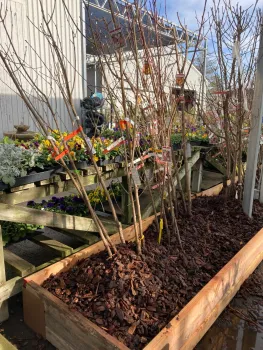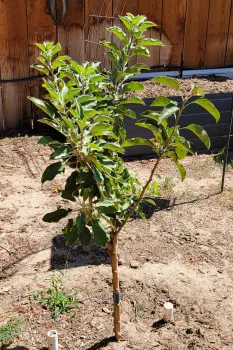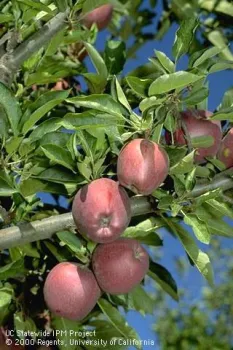
Nothing says fall like biting into a fresh, crisp apple. While a few varieties are available in stores, growing your own apples can be a rewarding experience, providing you with varieties unavailable at the supermarket. This article includes information to assist home gardeners in selecting the right varieties for our climate, planting instructions, and managing pests. We will cover the key points to consider and provide resources for gardeners to consult.
Site Selection: The Foundation for Success
Choosing the proper location is critical for a healthy, productive apple tree. Apples require a site with at least six to eight hours of direct sunlight per day, especially the morning sun, which helps dry dew from the leaves and may reduce the risk of some disease.
Apple trees can tolerate a variety of soil types but thrive in deep, well-drained loamy soils. If you have heavy clay soil, consider planting on a slight mound or in a raised bed to ensure good drainage and prevent crown and root rot.
Choosing Varieties for California's Climate
Many traditional apple varieties require significant "chill hours"—the number of hours between 32 and 45°F during the winter dormant season. In many parts of California, particularly the warmer southern and coastal areas, winters are not consistently cold enough to meet these requirements. For these regions, UC ANR recommends selecting low-chill varieties such as 'Anna', 'Dorsett Golden', 'Fuji', and 'Gala', ‘Gravenstein’, ‘Red Delicious’, and ‘Golden Delicious’. 'Anna' and 'Dorsett Golden' are particularly well-known for their low-chill requirements and planting them together ensures cross-pollination. Multi-budded trees, which feature several low-chill varieties grafted onto a single rootstock, are also an excellent option for home gardeners with limited space.
It's also important to consider pollination. While some varieties, like 'Golden Delicious', are self-fertile, most apples require cross-pollination from another apple variety that blooms at the same time.
Planting and First-Year Care

Nurseries and garden centers may sell dwarf, semi-dwarf, or standard trees. However, the term “semi-dwarf” is misleading, as trees can grow up to 18 feet tall. This makes it difficult for home gardeners to prune trees or to reach fruit without a ladder. We recommend keeping trees small right from the beginning. Learn how by visiting the Dave Wilson Backyard Orchard Culture website or Youtube video on Backyard Orchard Culture listed under the resources heading below.
The best time to plant bare-root apple trees in California is in winter, usually January and February. Look for dormant trees (without leaves) sold at local nurseries and garden centers that are buried in sand, bark, sawdust, or other materials. If sold in a bag, be aware that the roots may not be as healthy. Before purchasing a bare root tree, make sure you are ready to go home and plant it, or put it into the same material as at the nursery, otherwise the roots may dry out.
It is not recommended to add anything to the planting hole, such as an amendment or fertilizer. When planting, the hole should be twice as wide as the root spread but not too deep. Create a cone of soil in the center of the hole and spread the roots over it. Ensure the graft union, the swollen area where the variety is grafted to the rootstock, is several inches above the soil line. Fill carefully around the roots with soil. After planting, water the tree thoroughly to settle the soil and eliminate air pockets.
Water and Fertilizer Management
Apple trees require consistent irrigation, particularly during their first year and during fruit development. Stress from insufficient water can reduce fruit quality and make trees more susceptible to pests and diseases. Drip irrigation or soaker hoses are ideal for providing deep, slow watering. As the tree matures, its roots will spread, so irrigation should be adjusted to water a wider area farther from the trunk. For young trees, fertilizer can be broadcast around the tree in the early spring after leaves appear. As trees mature, a moderate annual fertilization program is usually sufficient; always follow directions on how much to apply.
Pest and Disease Management

Common apple pests include codling moth, aphids, spider mites, and borers. Common diseases include apple scab, fire blight, and powdery mildew. Good sanitation, such as removing fallen leaves and pruning diseased branches, is key to helping prevent some problems.
If you know the pest or disease affecting your tree, learn more about it by visiting the UC IPM Website. If you can’t identify the problem, contact your local UC Master Gardener Program using the Find a UC Master Gardener Program link.
Pruning and Thinning
Annual pruning is essential for maintaining a healthy, productive apple tree. Pruning is typically done in the dormant season to shape the tree and remove dead, diseased, or crossing branches. However, summer pruning is necessary to manage tree size and encourage next year's blossoms. It's important to note that apples grow on spurs; recognizing them is important so you don't prune them off. See details under "pruning tips" below.
Equally important is fruit thinning. In May, when fruits are still small, thin them to a single apple per spur, spaced about six inches apart. Thinning improves fruit size, prevents branch breakage, and promotes more consistent bearing each year.
Home gardeners across the valley can enjoy a bountiful harvest of fresh, homegrown apples. From selecting low-chill varieties suited for warmer climates to following best practices for planting, watering, and pruning, successful apple growing is within reach. Go to the University of California Agriculture and Natural Resources (UC ANR) for additional comprehensive, research-based information.
Additional information and resources:
Dave Wilson, Backyard Orchard Culture. https://www.davewilson.com/home-garden/backyard-orchard-culture/
UC Master Gardeners of Stanislaus County, YouTube Video: Backyard Orchard Culture https://www.youtube.com/watch?v=ry4YAp6NzdI&t=2695s
UC Master Gardeners Marin County: Guide to growing apples: https://ucanr.edu/site/uc-marin-master-gardeners/documents/apple
UC IPM: Fruit Tree Pests, Apples https://ipm.ucanr.edu/PMG/GARDEN/FRUIT/apples.html
Pruning Tips from UC Master Gardeners of Marin https://ucanr.edu/site/uc-marin-master-gardeners/documents/pruning-apple
Barbara Kissinger-Santos has been a UC Master Gardener in Stanislaus County since 2024
